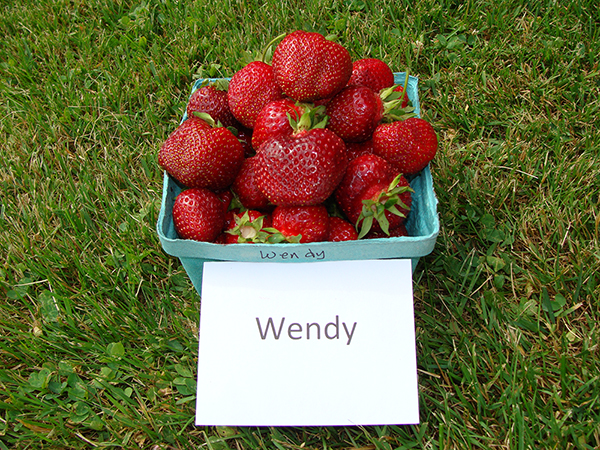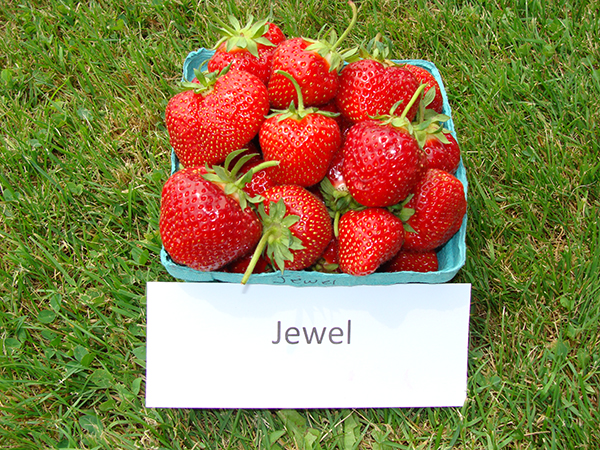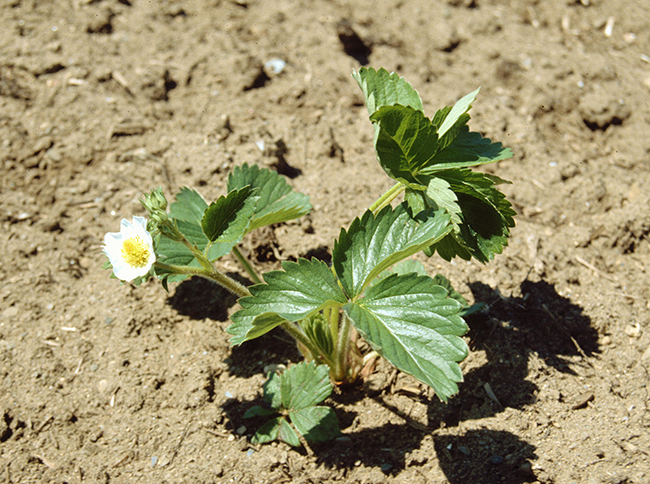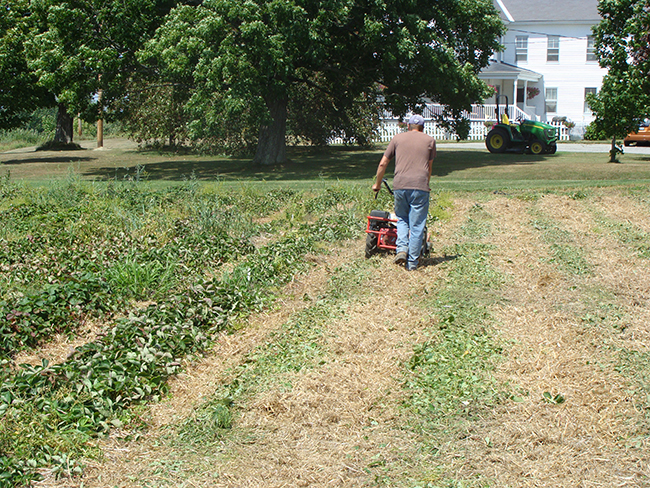Bulletin #2067, Growing Strawberries

Prepared by David T. Handley, vegetable and small fruit specialist, University of Maine Cooperative Extension
For information about UMaine Extension programs and resources, visit extension.umaine.edu.
Find more of our publications and books at extension.umaine.edu/publications/.
Table of Contents:
- Selecting a Planting Site
- Preparing the Soil
- Suggested Varieties
- Planting and First Season Care
- VIDEO: How to Grow Strawberries: Planting A Strawberry Bed (YouTube)
- Mulching
- VIDEO: Getting Strawberry Plants Ready for Winter (YouTube)
- Renewing the Planting
- VIDEO: How to Grow Strawberries: Renovating an Old Strawberry Bed (YouTube)
- Disease and Insect Control
- VIDEO: How Do I Grow Strawberries in the Off-Season? (YouTube)
Strawberries are an excellent crop for both home gardeners and commercial farmers in New England. With proper care, strawberry beds will produce good crops for three to five years, beginning one year after planting. An initial planting of 100 plants should provide enough fruit for a family of four, with a surplus to freeze or make preserves.
Selecting a Planting Site
Choose your planting site carefully. Strawberries grow best in deep, sandy loam soil, rich in organic matter. The soil must be well drained. Keep away from areas that remain wet late into the spring. The site should receive full sunlight and have a gradual slope. This helps prevent frost injury by allowing cold air to drain away from the plants.
Do not plant strawberries where tomatoes, potatoes, peppers or eggplant have been grown in the past four years. These crops carry the root rot fungus Verticillium, which also attacks strawberries. In addition, do not plant strawberries into recently plowed grass sod areas. This can lead to devastating weed problems and damage by white grubs, a common turf pest that will feed upon strawberry roots.
Finally, choose a site where there is ready access to a water supply. Irrigation is important for good plant growth during dry periods, and can also be used to prevent frost injury in the spring.
Preparing the Soil
Getting a site ready for strawberry planting may take up to two years, depending upon its present condition. Have the soil tested for pH and fertility levels. Strawberries prefer a soil pH of 5.8 to 6.2; this may require applications of ground limestone to increase the pH of more acid soils. Soil testing information is available at your local UMaine Extension County Office.
If the organic matter level of the soil is low and/or perennial weeds are a problem, cover crops such as buckwheat or oats can be sown and plowed into the soil before going to seed. There should be time for two sowings in a single season. Applications of barnyard manure or compost and regular tilling for a full season may be used as an alternative to cover crops.
In the spring of the planting year, broadcast 20 pounds of 10-10-10 garden fertilizer per 1,000 square feet of the site. Cultivate the soil to incorporate the fertilizer and break up any clumps or clods several days before planting. Organic fertilizer sources such as compost, manures, sul-po-mag, and rock phosphate may be used in place of synthetic fertilizers. Apply enough of these materials to deliver two pounds each of nitrogen, phosphorus (P2O5) and potassium (K2O) per 1,000 square feet.
Suggested Varieties
There is a wide selection of strawberry varieties to choose from that will perform well in New England, but it is important to select types that have resistance to red stele and Verticillium root rots, produce vigorous plants, and have a consistent record of good yields and high-quality fruit. Listed below are varieties that have performed dependably in Northern New England. Further details on various characteristics and performance are available from your Cooperative Extension office.
- Earliglow: An early berry of high quality. The fruit is firm with excellent flavor and color. Yields may be low in New England. Fruit size tends to decrease as the season progresses. Plants are vigorous runner producers.
- Wendy: Early ripening and productive. Medium-sized fruit with good flavor and color. Plants are vigorous and produce runners freely.
- Cavendish: Very productive. Large, firm fruit with good flavor, but with an uneven ripening habit. Plants are moderately vigorous.
- Flavorfest: Mid-season ripening with a nice appearance and very good flavor. Plants are disease resistant.
- Jewel: Glossy, attractive, medium-sized fruit with firm texture and flavor. Good production. Plants are vigorous.
- Allstar: Berries are large, conical, and light red to orange with a mild, sweet flavor. The plants are vigorous and make runners freely.
- Sparkle: Fruit flavor is excellent, but the fruit is dark red and somewhat soft. Fruit size tends to decrease as the season progresses. Plants are vigorous and produce many runners.






It is usually best to plant two or more varieties. The performance will vary according to the conditions at each site. Try new varieties in small trial plantings, next to a variety with which you are familiar.
Planting and First Season Care
Strawberries should be planted in the spring as soon as the soil is dry enough to be prepared. Purchase only certified disease-free plants from a reputable nursery. Plants should have large crowns with healthy, light-colored roots.
Strawberries should be planted in holes large enough to slightly spread the roots out, and deep enough to bring the soil half way up the crown. Pack the soil firmly around the plants, and irrigate immediately after planting.
The best planting system for most gardens is the matted row. For this system, strawberries should be planted 18 inches apart within rows, with 48 to 52 inches between rows. Soon after planting, the crowns will produce a few leaves, and flower buds will emerge. During the planting year, all flowers should be pinched off. This encourages runner growth and plant vigor to fill out the bed, leading to better yields next year. Runner plants will begin to emerge from the crowns in the early summer. These should be used to fill out the rows.






The width of each row should be limited to 24 inches to maintain easy access in the planting. The runners can be positioned into the desired row width before they root and held in place with small stones, clumps of soil or old-fashioned hairpins. Runner plants that grow outside the 24-inch row width should be pinned back into the row to root or be removed if the plants become too crowded (less than six inches between plants).

Be sure to control all weeds that emerge during the season. Weeds will take over a strawberry bed and seriously reduce yield. Frequent, regular cultivation by hoeing or hand pulling weeds will greatly increase the life of a strawberry planting. Irrigate plants regularly to ensure optimum growth. One to two inches of water per week is ideal.
Mulching
Mulch should be applied over strawberries in the late fall (mid-November) to protect the plants from extreme winter cold and from damage to the roots caused by rapid freezing and thawing of the soil. Straw is the most commonly used mulch, but any loose material which will provide cover without matting can be used, such as pine needles or wood shavings. Do not use hay, because it contains weed seeds that will start to grow among the strawberries next spring. The mulch layer should be six to eight inches deep over the plants.
In the early spring (mid-April), the mulch should be pulled off the plants and placed into the aisles between rows. This creates a clean walkway and will keep the fruit dry and clean. If a frost is predicted after the mulch has been removed, it may be raked back over the plants for the night to protect the flower buds.
Irrigation is another way to provide frost protection. Set up sprinklers to provide complete coverage of the planting, and turn the water on when the temperature drops to 33 degrees F. Continue to run the water until all the ice formed on the plants has completely melted. Special frost nozzles can be purchased for some types of sprinklers which will emit only enough water to protect the flowers and not flood the beds.
“Floating” fabric row covers may also be placed over the plants to provide some winter and frost protection. These lightweight fabrics create a greenhouse effect that will make the plants bloom and fruit earlier in the spring and produce larger yields.
Row covers can be placed over the plants in the early fall or the early spring. Plants covered in the fall will have greater yield benefits from the covers, but additional mulch such as straw should be applied in mid-November for extra winter protection. Remove the straw in late March, or as soon as the snow melts, leaving the row covers in place.
Row covers can also be applied only in the early spring. Mulch should be applied as usual in the fall, but removed early in the spring (in late March or early April) and followed immediately by applying the row covers. While this may not provide as high a yield increase as the fall application, it avoids the practical problems of applying mulch over the covers. Leave the row covers on until the plants begin to bloom. This may occur two to three weeks earlier than plants without row covers, so you must be prepared to protect the flower buds from frost. Although the row covers will provide some frost protection, it is best to mulch or use irrigation over the row covers if a hard frost is predicted.
Harvest typically begins about three weeks after full bloom, and extends three to four weeks, depending on varieties and weather. Once the fruit starts to ripen, harvest regularly, every two to three days to prevent over-ripe fruit from attracting pests and encouraging fruit rots.




Renewing the Planting
Strawberry beds can usually be carried over for three to five years or more, if the plants are vigorous, the bed is kept weed free, and the planting is properly renewed or renovated every year. The bed should be renovated shortly after the harvest is complete, usually late July.
First, mow all the leaves off the strawberries, about one and one-half inches above the crowns. Fertilize the plants by broadcasting 20 pounds of 10-10-10 (or organic equivalents) per 1,000 square feet.
Next, narrow the plant rows to a strip 10 or 12 inches wide with a rototiller or spade, and spread a light, one-half to one-inch layer of soil over the remaining plants, but do not bury the crowns. If necessary, thin the remaining plants, leaving only the most vigorous and healthy. Irrigate the planting well, wetting the soil to a depth of six inches. During the summer, runner plants will emerge and should be placed to fill out the row to the desired two-foot width, similar to the planting year.
Keep the planting healthy and vigorous throughout the season by controlling weeds, maintaining the proper plant density and row width, and watering regularly.



Day Neutral Strawberries
Day neutral strawberries are a different type of plant that flowers throughout the summer months and into the fall, providing fruit well after June-bearing strawberries have stopped. The productivity and fruit quality of day neutral strawberries are much better than the old “everbearing” types, such as Ozark Beauty, and should be used in place of them. Because of their unique growing habit, day neutral strawberries must be treated differently than the June bearing types.
Site selection and soil preparation for day neutral strawberries should follow the same guidelines described for June-bearing strawberries.
Day neutral strawberries are easiest to manage on raised beds. The beds should be six inches high and 24 inches across on the top. The beds should be four feet apart on center, leaving about two feet between beds for a walkway. Plant two rows of strawberries on each bed. The rows should be one foot apart (six inches from the left and right of the center of the bed). Plants within the row should be eight to ten inches apart. It is best to stagger the plants in the two rows on a bed such that a plant in one row corresponds to the space between plants in the other row.
Plant the crowns in the early spring, and mulch around the plants with two to three inches of straw, pine needles, or wood shavings. Alternatively, the beds can be covered with black plastic mulch and the crowns planted through it. Black plastic offers good weed control and warms the soil to promote earlier growth. Pinch off all flowers that appear for four to six weeks after planting. Plants should then produce fruit in about six weeks and will continue producing until frost. Remove all runners to keep aisles clear and improve fruit quality. Water plants regularly to improve fruit size. A light side dressing of 10 pounds of 10-10-10 fertilizer (or its equivalent) per 1,000 square feet should be applied in early August.



Day neutral strawberries should be grown as an annual, to be plowed down the spring after planting and replanted every year. Beds can be carried over if they are healthy and weed-free, but yields from day neutral strawberries tend to decline dramatically in successive years. Mulch the beds in the late fall as described for June bearing types. Remove the mulch in the spring and pinch blossoms for the first four to six weeks to improve later yields.
If allowed to fruit, the plants will bear a heavy early crop followed by a smaller summer and fall crop. Fertilize in the spring with 20 pounds of 10-10-10 (or its equivalent) per 1,000 square feet. It is recommended that beds not be replanted to strawberries for at least three years to prevent the proliferation of root diseases. Plant alternative crops such as most vegetables or cover crops to build soil organic matter for the duration, and grow the next crop of strawberries in another bed.
The best day neutral strawberry varieties for New England are Seascape, Albion, Tribute, and Tristar. Seascape is a California variety with large fruit and good yields. Albion is also from California, it ripens later than Seascape, but has larger, firmer fruit with good flavor. Tribute and Tristar are older, east coast varieties with smaller fruit, but good disease resistance. Tribute tends to produce more fruit than Tristar, but it also produces more runners, which should be cut off. Both varieties have very good fruit quality.
Disease and Insect Control
Strawberries are subject to attack by fungus diseases, such as root rots and gray mold, and several types of insects, including tarnished plant bugs and strawberry bud weevils, but many problems can be prevented with proper planning and care. Plant varieties that are resistant to red stele and Verticillium root rots. Discourage insect pests by keeping the planting weed-free. Prevent gray mold by keeping the plant rows narrow to improve air circulation and mulching between rows.
For specific pest identification and control measures, contact your local UMaine Extension County Office.
Information in this publication is provided purely for educational purposes. No responsibility is assumed for any problems associated with the use of products or services mentioned. No endorsement of products or companies is intended, nor is criticism of unnamed products or companies implied.
© 2003, 2011, 2022
Call 800.287.0274 (in Maine), or 207.581.3188, for information on publications and program offerings from University of Maine Cooperative Extension, or visit extension.umaine.edu.
In complying with the letter and spirit of applicable laws and pursuing its own goals of diversity, the University of Maine System does not discriminate on the grounds of race, color, religion, sex, sexual orientation, transgender status, gender, gender identity or expression, ethnicity, national origin, citizenship status, familial status, ancestry, age, disability physical or mental, genetic information, or veterans or military status in employment, education, and all other programs and activities. The University provides reasonable accommodations to qualified individuals with disabilities upon request. The following person has been designated to handle inquiries regarding non-discrimination policies: Director of Institutional Equity and Title IX Services, 5713 Chadbourne Hall, Room 412, University of Maine, Orono, ME 04469-5713, 207.581.1226, TTY 711 (Maine Relay System).


